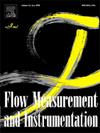CFD analysis of geometry configuration and sensor placement for hybrid triangular-T bluff body in vortex flowmeter
IF 2.3
3区 工程技术
Q2 ENGINEERING, MECHANICAL
引用次数: 0
Abstract
Vortex flowmeters are extensively employed in industrial settings for precise fluid flow measurement. This study aims to enhance vortex generation and pressure oscillation by extending tails in various lengths downstream of a triangular bluff body. Computational Fluid Dynamics (CFD) simulations were performed employing the Realizable k-ε turbulence model to study the geometry of the T-shaped bluff body and sensor placement for accurate flow measurement. A tail-to-width ratio (T/W) of 0.7 was identified as the most effective configuration for strong pressure fluctuations. Analysis of sensor placement indicated that the highest intensity of dynamic pressure oscillations was found at a distance of 7.9 times the width of the bluff body (X/W = 7.9) from the inlet. Additionally, variations in velocity, dynamic and static pressure, and turbulent kinetic energy production and dissipation were investigated along the flowmeter's axis to confirm the ideal sensor location. Results demonstrated signal clarity and sensitivity of the flowmeter for the proposed geometry configuration and sensor placement, indicating the potential for improved measurement consistency. Rangeability assessment revealed a stable Strouhal number (0.26–0.27) over a broad range of Reynolds numbers, ensuring reliable performance across diverse flow rates compared to conventional flowmeters.
涡流量计三角- t型混合钝体几何结构及传感器布置的CFD分析
涡流流量计广泛应用于工业环境中进行精确的流体流量测量。本研究旨在通过在三角钝体下游不同长度的尾翼延伸来增强涡的产生和压力振荡。采用Realizable k-ε湍流模型进行了计算流体动力学(CFD)模拟,研究了t型钝体的几何形状和传感器的位置,以实现精确的流量测量。尾宽比(T/W)为0.7被确定为应对强压力波动的最有效配置。对传感器放置位置的分析表明,在距进气道7.9倍钝体宽度处(X/W = 7.9),动压振荡强度最高。此外,还研究了流速、动、静压以及湍流动能产生和耗散沿流量计轴线的变化,以确定理想的传感器位置。结果表明,在所提出的几何结构和传感器位置下,流量计的信号清晰度和灵敏度较高,表明测量一致性有可能得到改善。范围评估显示,在广泛的雷诺数范围内,斯特劳哈尔数稳定(0.26-0.27),与传统流量计相比,确保了在不同流速下的可靠性能。
本文章由计算机程序翻译,如有差异,请以英文原文为准。
求助全文
约1分钟内获得全文
求助全文
来源期刊

Flow Measurement and Instrumentation
工程技术-工程:机械
CiteScore
4.30
自引率
13.60%
发文量
123
审稿时长
6 months
期刊介绍:
Flow Measurement and Instrumentation is dedicated to disseminating the latest research results on all aspects of flow measurement, in both closed conduits and open channels. The design of flow measurement systems involves a wide variety of multidisciplinary activities including modelling the flow sensor, the fluid flow and the sensor/fluid interactions through the use of computation techniques; the development of advanced transducer systems and their associated signal processing and the laboratory and field assessment of the overall system under ideal and disturbed conditions.
FMI is the essential forum for critical information exchange, and contributions are particularly encouraged in the following areas of interest:
Modelling: the application of mathematical and computational modelling to the interaction of fluid dynamics with flowmeters, including flowmeter behaviour, improved flowmeter design and installation problems. Application of CAD/CAE techniques to flowmeter modelling are eligible.
Design and development: the detailed design of the flowmeter head and/or signal processing aspects of novel flowmeters. Emphasis is given to papers identifying new sensor configurations, multisensor flow measurement systems, non-intrusive flow metering techniques and the application of microelectronic techniques in smart or intelligent systems.
Calibration techniques: including descriptions of new or existing calibration facilities and techniques, calibration data from different flowmeter types, and calibration intercomparison data from different laboratories.
Installation effect data: dealing with the effects of non-ideal flow conditions on flowmeters. Papers combining a theoretical understanding of flowmeter behaviour with experimental work are particularly welcome.
 求助内容:
求助内容: 应助结果提醒方式:
应助结果提醒方式:


